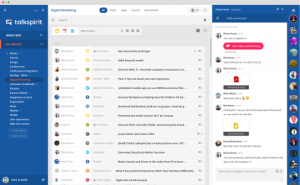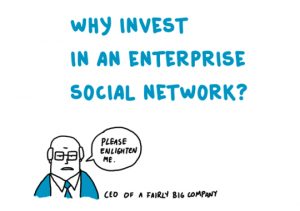
“Killing” the emails has never been our primary objective. However, here’s the result: after more than 3 years, we no longer use internal emails for work or information sharing within our organization.
With a little hindsight, here are 3 reasons why going back seems impossible for us and, to be honest, defy history.
1/ To master or to incur… it’s a question of choice
Everyone incurs constant email requests clogging their inbox and everyone complains about this fact, for good reason! The email inbox has become the receptacle of an ever-increasing number of unsolicited messages that we have to deal with and whose manual processing is time consuming.
Conversely, the workflow within a social network is based on making a decision: the one you make in order to join a group, to become someone’s friend and having your own daily news feed, are only the outcome of this choice. In this mode of access to information, everyone finds his or her freedom to decide what makes sense to set aside as less important, but that can still remain accessible without being notified.
This first reason is part of a broader paradigm shift that characterizes these new ways of working in organisations possessing a high degree of agility. In this new work environment, the time when the head of the organisation was the sole decision maker, which included choosing the information one could access, has vanished and is making space for a mode based on responsibility, freedom of choice and trust, in order to freely access shared information and content.
2/ Because it’s not just about sharing information
The second reason that makes the return to the email an impossibility for internal use is due to the daily information usage we have developed. talkspirit allows us to remain effortlessly synchronized throughout the day with the information that is useful to us, thus saving the time spent switching from one application to another in order to share this information. When necessary, shared information in groups, which is accessible and available to all, facilitates discussions, collaborations, and generally accelerates the decision-making process.
Examples?
When one of our clients requests assistance via a support ticket, this information available in our support app is also automatically transmitted to a support group on our social network. If the ticket holder needs the help of some of his colleagues to solve the issue, he or she can immediately discuss the matter with them and resolve the situation more quickly.
A new business opportunity that requires the intervention of technical resources for the drafting of an offer? All business opportunities are replicated in a group of our social network in order to facilitate the collaboration of all the necessary resources, but also to allow everyone to access the information contained in the CRM.
From these two examples, a simple search within our social network allows a 360-degree view of the activities with our clients.
Because it’s not just about conveying information (at first glance), but about collaboration and better decision-making by mobilizing collective intelligence more easily. Because it’s basically about finding new ways of working, the enterprise social network gives rise to new perspectives that were simply impossible with the email or the Intranet.
3/ From a proprietary logic to a sharing logic
Finally, what is the most obvious argument, and the one that definitively sounds the death knell of emails for internal usage, is certainly the following: we have entered a new era where the company becomes a platform of collective intelligence, where the information is the essential fuel; an era where the complexity of situations has made collaborative work the norm.
In this new era, information infiltrates all company functions and trades, allowing for better understanding, therefore better decision-making, better control and faster execution. This information is no longer the property of one or a few people, but through its various roles, becomes the property of the organization. It’s the company model in itself that shifts from one which is a people-centered organisation based on a subordination logic to one that is a model structured around the work to be done in alignment with the purpose of the organisation.
In this liberated enterprise, in the sense of “liberating,” each employee has roles to fulfill. The information we share for the realisation of our missions is no longer our property but that of our roles. In the future, new colleagues will “assume these roles” and find all the information that has been shared. What happens in your company when a colleague leaves and is replaced by someone?
It’s up to you to decide, emails or no emails…

Defining new ways of working together is difficult. Yet, companies now require new practices, a fact that will gain in importance as time goes by… You’re already aware of this if your position is that of a decision-maker on these issues.
But what works well for a few individuals is difficult to scale to a team and to remain agile through its operation… The company struggles with its transformation. There’s too much isolation and bureaucracy…
The social network is a great transformation opportunity for your entire organisation. You may have already tried to make this change and were met with an unsuccessful outcome. This is the right time to renew your attempt but with a clearer vision, a stronger will and better tools.
An illustration can sometimes replace all the speeches… This one is rather spot-on in regards to the content of this article.

It’s your turn!
Philippe
Co-founder Talkspirit



